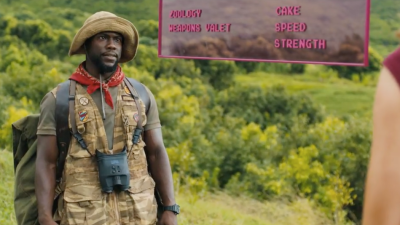
Jumanji: Welcome to the Jungle – (l to r) Franklin “Moose” Finbar (Kevin Hart), Dr. Smolder Bravestone (Dwayne Johnson), Ruby Roundhouse (Karen Gillan) and Professor Shelly Oberon (Jack Black) – Photo by Frank Masi/Courtesy of Columbia Pictures.
Jumanji: Welcome to the Jungle may be the most authentic video gaming movie I’ve ever seen. Match that with a Breakfast Club/Indiana Jones vibe and the result is two hours of pure, high energy fun.
Welcome to the Jungle follows the basic template of the original film by having a kid play the game in 1996 and disappearing – leaving his shattered father alone in a once magnificent house that is now the neighborhood eyesore. The sequence also explains how and why Jumanji becomes a video game.
In the present, four high school kids – Spencer (Alex Wolff), Martha (Morgan Turner), Fridge (Ser’Darius Blain) and Bethany (Madison Iseman) – are given detention and assigned to clean out a room in the school basement to prepare for a new computer room.
Spencer is a nerd, with allergies and phobias– and supplier of a history paper to Fridge; Martha is the quiet girl who sees little point in Phys Ed class; Fridge is the football team guy who has little time for actual classes and has Spencer write a history paper for him, and Bethany is the self-absorbed girl who, after finishing a class pop quiz, phones a friend – in class – and argues with her teacher she’s ordered to put her phone away.
In short, the way each student gets their detention tells you who they are.

Jumanji: Welcome to the Jungle – (L-R) Spencer (Alex Wolfe), Fridge (Ser’Darius Blain), Bethany (Madison Iseman) and Martha (Morgan Turner) – Photo courtesy of Columbia Pictures.
Once in detention, they find the video game – with the Jumanji game still slotted into it – in a box marked donations.
Spencer persuades the group to play; they all select an avatar and, when they begin to play, suddenly they’re transported into a jungle!
Spencer’s avatar – Dr. Smolder Bravestone (Dwayne Johnson) – is a massive guy with a host of skills and no weaknesses; Martha draws Ruby Roundhouse (Karen Gillan), a Lara Croft type whose skills include dance-fighting and weakness is venom; Fridge finds himself stuck with Mouse Finbar (Kevin Hart) – a diminutive zoologist whose big weakness is cake, and Bethany discovered that with her cartographer avatar, Dr. Shelly Oberon (Jack black), the Shelly stands for Sheldon and his weakness is endurance.
The game has a number of levels, each of which requires some kind of challenge to be overcome. Each player has three lives, and there are NPCs (non-player characters) to help and oppose them.
The object of the game is to find an emerald stolen from Jaguar Mountain and replace it. Standing in their way is Van Pelt (Bobby Cannavale) – an archaeologist who wanted to study it, but once he had it, became evil and gained the power to control all the animals in the jungle.

Jumanji: Welcome to the Jungle – Moose Finbar (Kevin Hart) – Photo courtesy of Columbia Pictures.
The avatars allow their players to poke gentle fun at themselves and gaming conventions (learning he’s inside the game, Spencer/Smolder pleads with himself, ‘Don’t cry! Don’t cry! Don’t cry!’; Martha looks at Ruby’s costume and is not happy; Fridge wants to know where the top half of his body has gone, and Bethany… let’s just say shock is the least of her reaction).
Along the way, they meet Seaplane (Nick Jonas), a pilot who has never managed to get past the Transportation Shed level. He also turns out to be the avatar of the boy we saw enter the game in 1996.
Over the course of the film, our intrepid heroes learn to work together and deal with their individual problems. An old friendship is rejuvenated (regenerated?), and there’s even a bit of romance.
What makes it all work is a clever script by Chris McKenna & Erik Sommers and Scott Rosenberg & Jeff Pinkner and equally facile direction by Jake Kasdan.
The cleverness of the script is the manner in which it incorporates gaming tropes into the action (Spencer’s discovery of how to look up traits, weakness and special skills; the tattoos that let them know how many lives they’ve got; the way their special skills make them work together, etc.) while letting the characters grow and develop while they’re learning how to navigate the world of Jumanji.
Jumanji: Welcome to the Jungle does pretty much everything it sets out to do: create a video gaming movie that feels like a real video game; take a group of disparate characters and turn them into a team, and entertain like crazy.
Final Grade: A-